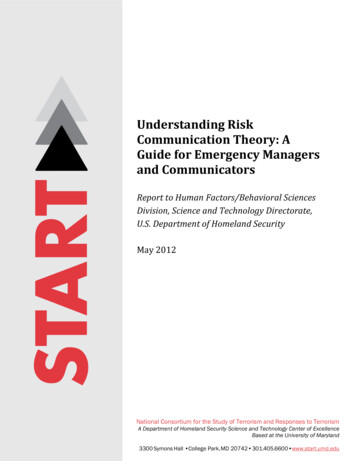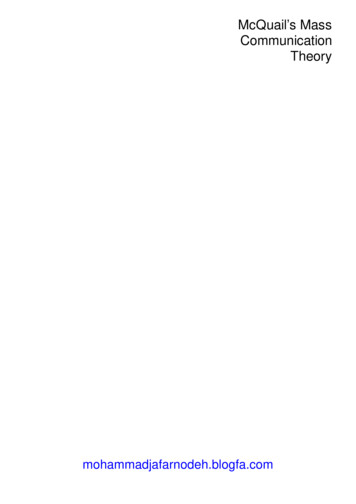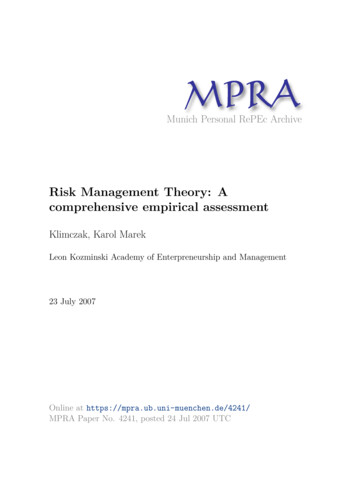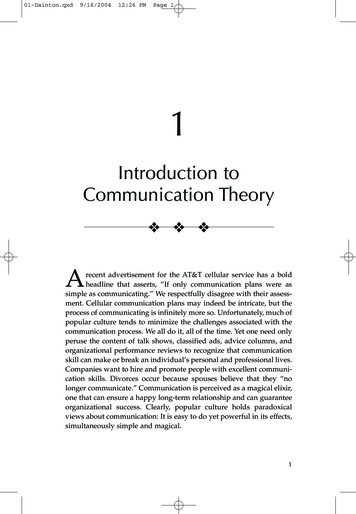
Transcription
Understanding RiskCommunication Theory: AGuide for Emergency Managersand CommunicatorsReport to Human Factors/Behavioral SciencesDivision, Science and Technology Directorate,U.S. Department of Homeland SecurityMay 2012National Consortium for the Study of Terrorism and Responses to TerrorismA Department of Homeland Security Science and Technology Center of ExcellenceBased at the University of Maryland3300 Symons Hall College Park, MD 20742 301.405.6600 www.start.umd.edu
National Consortium for the Study of Terrorism and Responses to TerrorismA Department of Homeland Security Science and Technology Center of ExcellenceAbout This ReportThe authors of this report are Ben Sheppard, Research Associate at START, Melissa Janoske,doctoral student at the University of Maryland, College Park, and Brooke Liu, AffiliatedFaculty Member for START. Questions about this report should be directed to Brooke Liu atbfliu@umd.edu.This research was supported by the Science and Technology Directorate of the U.S.Department of Homeland Security through Grant Award Number HSHQDC-10-A-BOA36made to the National Consortium for the Study of Terrorism and Responses to Terrorism(START). The views and conclusions contained in this document are those of the authorsand should not be interpreted as necessarily representing the official policies, eitherexpressed or implied, of the U.S. Department of Homeland Security or START.About STARTThe National Consortium for the Study of Terrorism and Responses to Terrorism (START)is supported in part by the Science and Technology Directorate of the U.S. Department ofHomeland Security through a Center of Excellence program based at the University ofMaryland. START uses state‐of‐the‐art theories, methods and data from the social andbehavioral sciences to improve understanding of the origins, dynamics and social andpsychological impacts of terrorism. For more information, contact START atinfostart@start.umd.edu or visit www.start.umd.edu.CitationsTo cite this report, please use this format:Sheppard, Ben, Melissa Janoske, and Brooke Liu. “Understanding Risk CommunicationTheory: A Guide for Emergency Managers and Communicators,” Report to HumanFactors/Behavioral Sciences Division, Science and Technology Directorate, U.S. Departmentof Homeland Security. College Park, MD: START, 2012.Research sponsored by:Understanding Risk Communication Theory: A Guide for Emergency Managers and Communicators
National Consortium for the Study of Terrorism and Responses to TerrorismA Department of Homeland Security Science and Technology Center of ExcellenceTable of ContentsIntroduction . 2Defining Risk Communication . 4Risk Characteristics . 6Risk Communication Theories and Models . 7Cross-cutting Theories and Models . 7Communication during the Preparedness Phase .11Communication during the Response Phase .16Communication during the Recovery Phase .18References .22Understanding Risk Communication Theory: A Guide for Emergency Managers and Communicators1
National Consortium for the Study of Terrorism and Responses to TerrorismA Department of Homeland Security Science and Technology Center of ExcellenceIntroductionThis document reflects the themes and concepts developed in the accompanying Understanding RiskCommunication Best Practices: A Guide for Emergency Managers and Communicators. This reportdiscusses and dissects theories and models relevant to federal, state, and local homeland securitypersonnel and emergency managers faced with communicating risks within their communities. It firstprovides a detailed discussion on defining risk communication, followed by risk characteristics tosummarize how perceived dread and familiarity can affect risk messaging. Next, relevant theories andmodels1 are discussed in two parts: cross-cutting theories and models applicable across thepreparedness, response, and recovery phases, and then additional theories and models that are mostrelevant within a specific event phase. As with the Best Practices document, many of the communicationapproaches presented were not originally designed for a specific event phase, but nevertheless offervaluable insights that make them particularly suitable for a specific event phase.This review presents concepts from a variety of academic disciplines, including communication,sociology, anthropology, political science, and psychology. This report thus captures the diversity of thefield of risk communication, including an analysis of key strengths and weaknesses of dominant theoriesand models, offering risk communicators and managers the opportunity to readily identify theinformation and research most relevant to their interests.For decades, scholars have been working to improve risk communication practice through developing,testing, and refining communication theories and models that endeavor to explain the expected andunexpected impacts of risk communication. These efforts have led to an abundance of scientificdiscoveries, but there is no single theory or model that captures the full range of considerations thatimpact risk communication efforts. When defining event phases within this report, the followingdistinctions have been utilized: Preparedness: pre-event risk communication outlining practical preparedness measures, includingeducation on likely risk characteristics of various threats (e.g., differentiating factors associatedwith an improvised nuclear device terrorist attack versus an earthquake);Response (Imminent Warnings): crisis communication and guidance regarding protective actionsto take immediately prior to, in the midst of, or during the hours immediately following an event;Recovery: messages communicating needs and guidance in the weeks, months, and years followingan event.The diagram below represents the relationship between the material presented in this document andmaterial presented in the corollary Best Practices report. For the best and most thorough overview,readers are encouraged to read and use both the Theory and Best Practices documents.In this document, we distinguish between theory and model where a model is an abstract representation of a system orprocess to help describe the consequences and interrelationships of decisions and events. A theory, then, is a set of ideasintended to explain and predict events.1Understanding Risk Communication Theory: A Guide for Emergency Managers and Communicators2
National Consortium for the Study of Terrorism and Responses to TerrorismA Department of Homeland Security Science and Technology Center of ExcellenceKey insights from this document include the importance of: Identifying the most exigent publics for risk messages (CERC Model; STP); Developing appropriate messages for the most exigent publics (CERC Model; STP); Understanding how publics process risk messages (STP; heuristic-systematic model); Understanding how to incorporate divergent viewpoints into risk messages (deliberative processmodel); Involving community members in disseminating preparedness messages (actionable riskcommunication model);Ensuring information comes from multiple channels and is repeated often (actionable riskcommunication model);Providing specific response strategies organizations and institutions can incorporate into their riskmessages during crises (image restoration and repair theory; SCCT);Examining the following factors, which influence the effectiveness of response strategies: crisistype, an organization or institution’s crisis history, and how publics perceive an organization orinstitution (SCCT);Understanding how publics perceive risk prior to disseminating risk messages (mental models;affect heuristic; extended parallel process model; theory of reasoned action; RISP model); Understanding Risk Communication Theory: A Guide for Emergency Managers and Communicators3
National Consortium for the Study of Terrorism and Responses to TerrorismA Department of Homeland Security Science and Technology Center of Excellence Identifying factors that affect how publics recover from risks that can be incorporated into riskresolution messages (CAUSE model; precautionary adoption process model); andUnderstanding the social context and secondary effects of risks (SARF).Taken as whole, the findings from this document and Best Practices provide a comprehensive overview ofthe current art and science of effective risk communication.Defining Risk CommunicationAll communities need a way to communicate about present, emerging, and evolving risks. There is ageneral consensus that risk communication is a two-way process between the communicator(s) and therecipients of the messages, but beyond that, different definitions often include unique variables andunderstandings. Risk communication definitions are often similar to the definition offered by Covello(1992), who wrote of the “process of exchanging information among interested parties about the nature,magnitude, significance, or control of a risk” (p. 359). Other definitions emphasize the importance of riskmanagement (McComas, 2006), the need for dialogue between communicators and stakeholders(Palenchar, 2005), and the necessity of ongoing risk monitoring (Coombs, 2012).Organized and centralized risk communication efforts grew out of legal and regulatory mechanismsregarding community right-to-know, enforced by the U. S. Congress and state and local governments, thatrequired organizations or institutions (specifically in chemical and manufacturing fields) to informcommunities of any potential consequences of their existence (Palenchar, 2008). Congressional actionfollowed a series of large chemical accidents in the U.S. during the 1980s (Palenchar, 2008), andgovernment-supported research that identified 7,000 hazardous material incidents between 1980 and1985 (Falkenberry, 1995). Legislation passed in the mid-1980s included the Emergency Planning andCommunity-Right-to-Know Act and Section Three of The Superfund Amendments and ReauthorizationAct that mandated chemical companies to inform the public of the type and quantities of chemicalsmanufactured, stored, transported and emitted in each community (Palenchar, 2008).As official risk communicators engaged with publics, interest increased in how such communicationcould be most effective, with initial questions focused on message creation but expanding to query howaudiences process and act on messages, leading to a deep body of risk communication research. BaruchFischhoff was one of the leading pioneers of risk communication research, which built on early riskperception work driven by Paul Slovic and Sarah Lichtenstein. Fischhoff worked in this area starting inthe late 1970s, culminating in the identification of seven evolutionary stages of risk communication andbest practices (1995):1) Get the numbers right;2) Tell key publics what the numbers mean;3) Explain what the numbers mean;4) Show publics they have accepted similar risks before;5) Explain how risk benefits outweigh the costs;6) Treat publics with respect; andUnderstanding Risk Communication Theory: A Guide for Emergency Managers and Communicators4
National Consortium for the Study of Terrorism and Responses to TerrorismA Department of Homeland Security Science and Technology Center of Excellence7) Make publics partners with risk communicators.8) Do all the above.Fischhoff’s perspective is supported by other researchers who believe that effective communication musttake into account how various publics perceive risk influenced by societal and cultural factors rather thanjust focusing on science (e.g., Adam & Van Loon, 2000; Campbell, 1996). However, since Fischhoff’sseminal work, additional factors have been identified that contribute to effective public warnings,including information on how special needs publics respond differently than the general public to risksand the role of media in educating the public about risks (see Best Practices).Historically, risk communication research tended to most frequently involve case studies and lists of bestpractices. The focus was often on organizational risks in the midst of a crisis, including reputation,response, and the success or failure of the organization in moving forward after the crisis, rather than onhow communication impacted the public and their behaviors (Heath & O’Hair, 2010). Common casestudies include Johnson & Johnson’s Tylenol tampering, the Exxon Valdez oil spill, the September 11thterrorist attacks, and Hurricane Katrina (e.g., Benoit, 1995; Berg & Robb, 1992; Carey, 2003; Liu, 2007;Procopio & Procopio, 2007; Torabi & Seo, 2004). A major advancement in the academic riskcommunication research of the 1990s and 2000s was the development of the mental models approach,which provides a framework to understand preexisting public perceptions of less-familiar and higherdread risks (discussed in detail later in this document).The rise of the risk communication field also saw the emergence of studies of crisis communication. Crisiscommunication, often conflated with risk communication, is a separate field, with its own issues andconcerns, but can include aspects of risk communication. More recently, however, crisis communicationresearch has emphasized the importance of experiments, while still maintaining the importance of casestudy research (e.g., Fediuk, Pace, & Botero, 2010). While crisis communication has historically focusedon image and reputation restoration, risk communication has a tradition of focusing on informationpresentation, persuasion, and strategic messaging. Additionally, failures at controlling or managing riskeffectively can lead to a crisis, or a crisis may lead to the necessity for risk communication (Coombs,2010). As such, Heath (2010) explained that “a crisis is a risk manifested” (p. 3). Furthermore, riskcommunication assists in message development prior to, during and after events, including emergingrisks that are currently not of primary public concern such as biosecurity or slow-burning issues such asthe safety of consuming genetically modified food. (Pidgeon, Harthorn, Bryant, & Rogers-Hayden, 2009;Renn, 2003).The conception of risk communication is derived from multiple fields of inquiry and notably overlapswith definitions of and research on crises and disasters. In the subsequent review, the term riskcommunication is used broadly to capture research on risk and crisis communication. The term crisiscommunication is also used when discussing research explicitly on the response phase.Understanding Risk Communication Theory: A Guide for Emergency Managers and Communicators5
National Consortium for the Study of Terrorism and Responses to TerrorismA Department of Homeland Security Science and Technology Center of ExcellenceThe next section reviews risk characteristics that affect how publics respond to risk messages, based onthe psychometric paradigm.Risk CharacteristicsEffective risk communication efforts must be adapted to match the type of risk. Before delving into thedetails and nuanced understandings of a variety of risk communication theories and models, this reportpresents a discussion of two key event characteristics that impact risk perceptions and behaviors basedon Slovic’s psychometric paradigm:2 the degree of dread associated with a risk and the public’sfamiliarity with a risk.1. Lower familiarity/lower dread (Examples: Rare agricultural diseases such as foot-and-mouth disease;oil terminal explosion). The public perceives lower familiarity/lower dread risks as rare and unlikely tobe life threatening or cause serious injuries. In practice, these risks may not be immediately lifethreatening, but rather delayed, manifesting over a period of months or years. Further, in some cases theperception of risk is greater than the actual risk: Individuals tend to overreact to those risks that are hardto understand, involuntary, and invisible despite evidence and reassurances by experts that a particularrisk is minimal or unlikely (Rogers, Amlot, Rubin, Wessely, & Krieger, 2007).2. Lower familiarity/higher dread (Examples: Chemical, biological, radiological, and nuclear (CBRN)terrorism; nuclear power plant accidents). A significant communication challenge is informing the publicof lower familiarity/higher dread risk events. International risks like terrorism are a particularly complexhazard for individuals and publics to interpret, respond to, and prepare for as they involve the intentionsof other people, and those are often hard to understand (Rogers et al., 2007). Compared to improvisedexplosive devices (IEDs), CBRN devices have lower familiarity and higher dread risk characteristics astheir effects may be delayed, unknown, and remain in the environment for years (Sidell, Patrick, &Dashiell, 1998).3. Higher familiarity/lower dread (Examples: Natural disasters such as earthquakes, tornados, and floods).The public is likely to have a general understanding of the risk characteristics of higher familiarity/lowerdread risks through either personal experience or media coverage. Effects of these risks are moreobservable, easier to understand, and shorter term. Further, it is possible to provide warnings for theserisks, making the public more likely to respond (Mileti & Sorensen, 1990; Slovic, 2000). At the same time,however, these risks contain dread attributes of being involuntary and having the potential to causefatalities.4. Higher familiarity/higher dread (Examples: IED terrorist attack; pandemic flu). Higherfamiliarity/higher dread risk events are those that are life threatening, less observable, and lack warning,but the public may have a greater understanding or awareness of them and ability to comprehend themThe psychometric paradigm seeks to identify, characterize, and quantify risk to enable communicators to have a baselineunderstanding of how their target audience might perceive and respond to risks (risk perception). This in turn provides abasis for improving dialogue with the public (risk communication) prior to an event (Slovic, 2000).2Understanding Risk Communication Theory: A Guide for Emergency Managers and Communicators6
National Consortium for the Study of Terrorism and Responses to TerrorismA Department of Homeland Security Science and Technology Center of Excellenceonce they occur. Compared to CBRN devices such as anthrax, non-CBRN events like IEDs cause less fearas their effects are not delayed and their characteristics are easier to understand by the public (Burns,2007), making their familiarity comparatively higher. Higher dread risk events have enormous secondaryeffects (also referred to as ripple effects) that extend beyond the immediate direct damage to encompassmany other victims. The events of 9/11, for example, caused secondary effects such as dramatic domesticpolicy changes that included the creation of the Department of Homeland Security, the ratification of thePATRIOT Act, and revised airport passenger screening measures.Risk Communication Theories and ModelsWithin risk communication, both theories and models are used and discussed to describe, predict, andtest a multitude of variables and interacting agents. This section will include both theories and models,and aims to showcase how they can be used in conjunction to provide a broader, more in-depth picture offactors necessary for successful risk communication. The section is divided into two parts. First, crosscutting theories and models that are applicable to the all three risk phases (preparedness, response, andrecovery) are presented, given their overarching characteristics. Second, theories and models that aremost applicable to a specific risk phase are discussed.Cross-cutting Theories and ModelsThis section reviews theories and models that apply to communication in multiple risk phases: the crisisand emergency risk communication (CERC) model, the situational theory of publics, the heuristicsystematic model, and the deliberative process model. Below is a summary of these theories and models’key contributions, which are then discussed in greater detail.Cumulative Guidance: Cross-Cutting Identify the most exigent publics for risk messages (CERC Model; STP)Develop appropriate messages for the most exigent publics (CERC Model; STP)Understand how publics process risk messages (STP; heuristic-systematic model)Understand how to incorporate divergent viewpoints into risk messages (deliberativeprocess model)Crisis and Emergency Risk Communication (CERC) Model. The Centers for Disease Control and Prevention(CDC) crafted the CERC model after the 9/11 attacks and the 2001 anthrax attacks to combine image andreputation research with persuasion and strategic messaging research (Seeger, Reynolds, & Sellnow,2010). The model is split into five stages and each stage provides a broad set of strategies andsuggestions for communication. CERC further discusses who should be seen as the most exigent public ateach stage and the types of messages that should be directed to those groups (Reynolds, Galdo, & Sokler,2002). The stages are:Understanding Risk Communication Theory: A Guide for Emergency Managers and Communicators7
National Consortium for the Study of Terrorism and Responses to TerrorismA Department of Homeland Security Science and Technology Center of Excellence Pre-crisis – Communication is directed to the public and response community to provide riskmessages, warning, and guidance regarding preparation. Strategies include building alliances,developing consensus recommendations, and testing messages with specific publics. Initial event – Communication is directed to the general public and affected groups to reduceuncertainty and increase self-efficacy and reassurance. Strategies include informing in thesimplest terms, establishing spokesperson credibility, and providing emergency courses of action. Maintenance – Communication is directed to the general public and affected groups to continuethe communication efforts from the initial event. Strategies include providing necessarybackground information, listening to public feedback, correcting misinformation, and empoweringdecision making. Resolution – Communication is directed to the general public and affected publics to provideupdates regarding resolution and discuss causes and new risks or new understandings. Strategiesinclude examining problems and reinforcing what worked, persuading publics to supportnecessary policy and resource allocation, and promoting and reinforcing the identity and abilitiesof the organization communicating the risk resolution. Evaluation – Communication is directed to agencies and response communities to discuss theadequacy of response and work toward lessons and new understandings. Strategies includeevaluating communication plan performance, documenting lessons learned, and determiningspecific actions to improve the crisis plan.Planning for a major crisis is fraught with challenges, but CERC has key strengths, including facilitatingdecisions that must be made within severe time constraints (Palenchar, 2010) and cautioning againstexcessive pre-crisis communication (Reynolds, Deitch, & Schieber, 2006). Overall, CERC is a model thatsupports pre-crisis communication as a method to increase the effectiveness of the response stages andreduce harm in the resolution stages (Seeger, Reynolds, & Sellnow, 2010). CERC was widely used in theaftermath of Hurricane Katrina and has also been tested as a model for communicating about the avianinfluenza pandemic (Seeger, Reynolds, & Sellnow, 2010). When used in response to avian influenzapandemics, CERC was viewed as a successful way to counter and avoid rumors, set rules for informationreleased to the media and involvement, engage and inform international audiences, and respond to andcontain criticism of response efforts (Seeger, Reynolds, & Sellnow, 2010).Situational Theory of Publics. The situational theory of publics (STP) aims to help institutions andorganizations identify whom they should consider as publics, and then to see how those publics engage incommunication behaviors such as information seeking and processing (Grunig, 2003). The three mainelements of the theory are problem recognition (detection of a problem with no immediate solution),constraint recognition (identification of perceived obstacles to finding a solution), and level ofinvolvement (extent of perceived connection to the problem) (Kim & Grunig, 2011). Taken together,these factors can determine if people will process information and then stop, or actively seek outUnderstanding Risk Communication Theory: A Guide for Emergency Managers and Communicators8
National Consortium for the Study of Terrorism and Responses to TerrorismA Department of Homeland Security Science and Technology Center of Excellenceadditional information—making STP one of the only theories to focus specifically on information seekingand processing as a way to predict behavior (Grunig, 1997). STP has since been expanded to thesituational theory of problem solving by including an additional variable, communicative action inproblem solving, which involves a potential problem-solver increasing active or passive informationseeking, selecting, and giving (Kim & Grunig, 2011). To date, the new version of STP has been tested onlythrough structural equation modeling based on web surveys of over 1,700 college students in the UnitedStates (Kim & Grunig, 2011).STP offers information that is useful in understanding why publics communicate and when they are mostlikely to do so (Aldoory & Sha, 2007), acknowledging that problem recognition and level of involvementcan be influenced by perceived shared experience with media spokespeople and their messages (Aldoory,Kim, & Tindall, 2010). For example, surveys reveal that publics that feel a connection with thespokespeople delivering messages are more likely to have increased problem recognition andinvolvement. With a stronger understanding of spokesperson impact, risk communicators can choosemore effective ways to disseminate information and engage publics.Heuristic-Systematic Model. While CERC and STP can help risk communicators predict and explain thebehavior of publics, the heuristic-systematic model allows communicators to see and understand theconnections between a person’s desire for accurate and sufficient information and the motivation forprocessing that information (Griffin et al., 2002). Affect, or how one thinks and feels, influences how apublic may judge an activity and the resulting decisions they make. The heuristic piece of the model looksat how publics use superficial cues such as the use of color, visuals, or identity of the source to processinformation; the systematic piece of the model looks at how publics comprehensively analyzeinformation to understand it; and the overall model states that publics will use superficial cues and/orcomprehensive strategies depending on the situation. Trumbo (2002) looked at three case studiesinvestigating suspected cancer clusters in individuals and found that superficial cues are associated witha lower evaluation of risk; that is, publics that focus on message credibility instead of message contenttend to assume there is a decreased importance of the risk presented. Additionally, being confident inone’s intellectual abilities is a good predictor of using shortcuts to make risk-based decisions (Trumbo,2002). In addition, Griffin, Neuwirth, Giese, and Dunwoody (2002) conducted more than 1,000 telephoneinterviews of adults living in the Midwestern United States and found that people use systematicprocessing when they have previous knowledge of or strongly held beliefs about the informationpresented. This previous interaction with the information allows individuals to further their knowledgeand to increase the strength of their attitudes toward the topic. Risk communicators with knowledge ofpublics’ processing abilities and interest can again adapt messages and determine how to best presentcomplicated information to the public.Deliberative Process Model. Beyond explaining and attempting to predict publics’ behaviors andmotivations for processing risk messages, the deliberative decision making process can guidecommunication development based on understanding what is required to create and sustain anatmosphere of tolerance, with plural viewpoints seen as legitimate (Pidgeon, Harthorn, Bryant, & RogersHayden, 2009; Renn, 2003). The process is best suited for an ongoing risk issue at the recovery stage, forUnderstanding Risk Communication Theory: A Guide for Emergency Managers and Communicators9
National Consortium for the Study of Terrorism and Responses to TerrorismA Department of Homeland Security Science a
readers are encouraged to read and use both the Theory and Best Practices documents. 1 In this document, we distinguish between theory and model where a model is an abstract representation of a system or process to help describe the consequences and interrelationships of decisions and events. A theory, then, is a set of ideas










